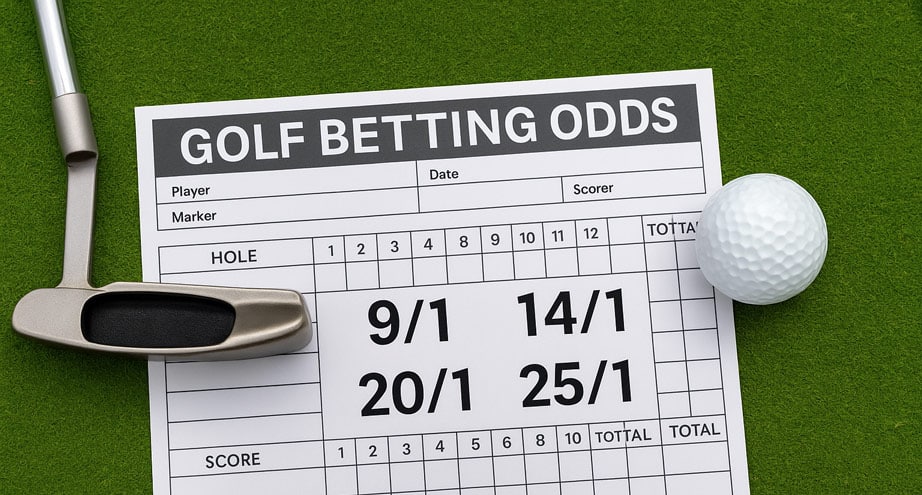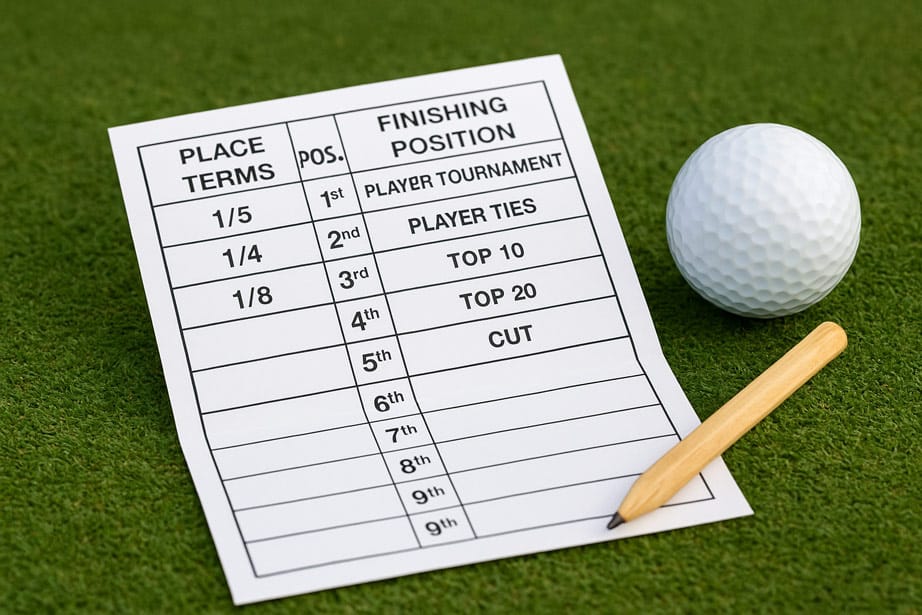
This guide explains golf betting odds in clear terms. You will learn the differences between fractional odds, decimal odds, and moneyline odds, how implied probability works, and how each-way terms affect potential returns. If you’re new to the sport, master the basics of how to bet on golf first, then use this page to get confident with the numbers.
Golf Betting Odds: Formats at a Glance
Bookmakers present golf betting odds in three common formats. The underlying value is identical; only the display changes.
- Fractional odds (UK): show profit relative to stake. Example: 10/1 returns £10 profit for every £1 staked, plus stake back if the bet wins.
- Decimal odds (EU): show total return per £1 staked. Example: 11.00 means £1 returns £11 total if the bet wins.
- Moneyline odds (US): use plus/minus. +500 means £100 wins £500 profit. −200 means you stake £200 to win £100 profit.

Implied Probability: Reading the Market
Implied probability converts any price into a percentage chance, letting you compare your estimate with the market.
- Decimal → probability: 1 ÷ decimal. Example: 6.00 → 16.67%.
- Fractional → probability: denominator ÷ (numerator + denominator). Example: 5/1 → 16.67%.
- Moneyline → probability:
- Positive: 100 ÷ (moneyline + 100). Example: +500 → 16.67%.
- Negative: moneyline ÷ (moneyline + 100). Example: −200 → 66.67%.
If your projection is higher than the implied probability in the price, you may have found value. That’s the core of beating golf betting odds over time.
How Each-Way Odds Work (With Examples)
An each-way bet splits your stake: half on the player to win, half on the player to place. Place terms are set per event (e.g., 1/5 odds for Top 8 in a major). Here’s how returns work in practice.
Example: £10 each-way at 20/1 with 1/5 place terms (Top 8).
- Total stake: £20 (£10 win + £10 place).
- Wins event: Win part → £10 × 20 + stake = £210. Place part uses reduced odds (20/1 × 1/5 = 4/1): £10 × 4 + stake = £50. Total £260.
- Finishes 3rd: Win part loses. Place part pays 4/1: £40 profit + £10 stake = £50.
Outrights vs Finishing Position vs Match Bets
Outright winner markets offer the highest prices and risk because fields are large. Finishing position markets like Top 5, Top 10, and Top 20 reduce risk since several results can cash your ticket. Match bets compare two golfers over a round or the whole event and are useful when one player’s course fit looks stronger.
In majors such as the Open Championship and the PGA Championship, fields are deep and conditions can be tough. Prices may be longer on outsiders, while books often offer extra places. In smaller events, look for golfers whose stats suit the setup—an edge that the market may underprice.
Reading Movement in Golf Betting Odds
Markets move for weather, tee-time waves, injuries, withdrawals, and heavy action. If you model a player at 10% to win, any decimal price longer than 10.00 can be attractive before the market tightens. Live markets react quickly to a hot start or late mistakes, so plan entries and avoid chasing steamed numbers.
Worked Payout Examples You Can Reuse
Fractional to decimal: 7/2 equals 3.5 decimal. A £20 stake at 7/2 returns £70 total; profit £50.
Decimal to profit: 5.50 with a £15 stake returns £82.50 total; profit £67.50.
Moneyline to decimal: +250 equals 3.50 decimal. −150 equals ~1.67 decimal. Convert to compare prices like-for-like across sportsbooks.
Quick Guide: Picking an Odds Format
- Decimal for fast math and easy implied probability.
- Fractional if you think in profit-first terms.
- Moneyline if you follow US media or models.
Expected Value and Bankroll Basics
EV estimates the long-term average of a price. A quick EV check can stop you taking poor numbers. Combine EV thinking with conservative staking so one bet never risks too much of your roll.
FAQs
Which odds format should I use? The one you can calculate fastest. Many bettors view golf betting odds in decimal for quick probability, then convert if needed.
Do each-way bets always pay the same? No. Books set the fraction and number of places per event. Check terms for every market.
Are moneyline odds worse or better? Neither. They’re just a different display. Convert to decimal to compare fairly.
Where To Go Next
Learn the essentials in our Beginner’s Guide, then scan live markets and previews on the Golf Betting & Odds page. For a deep dive into place terms, check our upcoming guide on Each-Way Betting in Golf.
👉 Want to give yourself an edge before betting? Head to our Promotions Page to profit from the latest sports betting offers.

